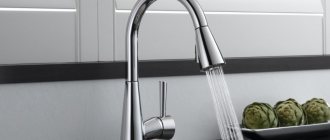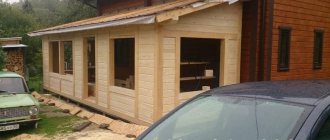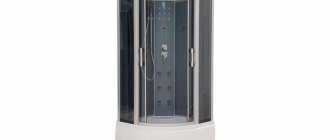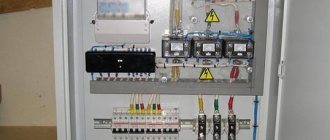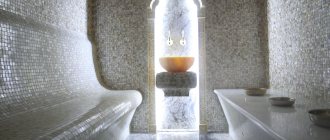Not all painting guns allow you to apply paint materials perfectly evenly and obtain a high-quality coating without drips or streaks. To achieve good results, it is recommended to use a pneumatic spray gun. The principle of its operation is to supply compressed air to the spray gun, which breaks the paint into many small drops. To achieve ideal application of the substance, it is important to choose the right compressor for the spray gun.
Choosing the right compressor for your spray gun is of great importance for successful operation
Regulators and their purpose
To successfully calibrate any device, you should know which elements of its design are responsible for changing performance indicators.
The effectiveness of setting up the tool configuration directly depends on a clear understanding of the purpose and operating principle of these elements. Fortunately, adjusting the spray gun is not very difficult and boils down to rotating 2-3 valves (depending on the model), which we will discuss later. Torch size regulator
A screw element that changes the position of a rod with a cone-shaped tip, reminiscent of a thick awl. Regulates the air pressure going to the head of the instrument by moving the rod closer or further from the through hole. The further the tip is located from the nozzle, the stronger the air pressure enters the head, creating a larger torch. The approach of the rod, on the contrary, limits the flow, reducing its influence on the formation of the torch. The maximum size of the torch is an elongated oval, and the minimum size turns it into a point.
Material supply
The flow of paint from the tank to the nozzle is blocked by a special needle, whose cone-shaped tip fits tightly to the inner walls of the nozzle. When the trigger is fully pressed, the needle moves back slightly, allowing the material to fall on the head of the spray gun and break into millions of tiny droplets under the pressure of the air flow. The feed screw adjusts the distance the needle will retract. Minimum paint supply means that the gap between the cone and the walls of the nozzle is very small and is not capable of passing a large amount of mixture. The maximum adjustment value, on the contrary, indicates that the needle moves a long distance, completely opening the exit to the air head.
Air supply
Fundamental setting of the optimal value of the input pressure required for the correct operation of the tool. Despite its importance, not all models are equipped with a built-in screw, forcing owners to resort to using third-party gearboxes (pressure gauges with regulators). Fortunately, more and more modern spray guns have the ability to change the air supply, without the need to connect third-party devices. Unlike the settings of the torch or material supply, which can be adjusted based on your needs, the volume of supplied air must have a single value specified by the manufacturer in the technical documentation. Reducing or exceeding the optimal threshold will distort the shape of the torch, making it unsuitable for professional work.
Rules for using the spray gun
To avoid problems when painting, you should not forget about important working rules. Professionals note the following nuances:
- Internal work requires the creation of good ventilation;
- When working outdoors, use the tool without direct sunlight;
- Compositions for cars are explosive and therefore require careful attention from the technician;
- Dilution of the solution is carried out strictly according to the instructions.
When working outdoors, use the tool without direct sunlight.
Setting the inlet pressure
The level of air flow pressure has a direct impact on the shape of the torch, where its excess deforms the spot into a dumbbell-shaped figure eight, and its deficiency guarantees paint accumulation in the center, but with a coverage area reduced by 60%. The quality and uniformity of material spraying by the tool depends on the value of this parameter. Many beginners, not understanding how to set up the spray gun, begin painting immediately after connecting to the compressor, which often causes serious inconvenience to themselves. There are several ways to set the optimal air supply, applicable to different life situations.
The exact pressure required by your tool to operate properly can be found in the technical documentation. The number with the prefix “bar” or “atm” is often indicated on tool packaging, and sometimes even on the pistol body.
Setting with pressure gauge
The most accurate and recommended way to adjust the spray gun inlet pressure. Requires a digital or dial gauge connected between the hose and the gun handle. Some modern models are equipped with a built-in electronic pressure gauge and do not require connecting additional equipment. For most instruments, especially the budget class, it is worth acquiring this measuring device. Setting the air supply can be done quite simply by following the simple steps of the instructions below.
Setting without a pressure gauge on the spray gun
A less accurate, but calculated way to set the optimal input pressure for device operation. If among spray guns, only 15% of models are equipped with a built-in or removable pressure gauge, then the presence of this important element in the compressor is mandatory in 100% of cases. It is based on the output pressure of the compressor receiver that you can determine how many atmospheres will be at the outlet of the air hose (or inlet to the spray gun).
Calculation of pressure reduction is based on the simplest formula “the pressure on the compressor pressure gauge, minus that lost in the hose and filter, is equal to the inlet pressure for the spray gun.” For example: the air pressure at the outlet of the compressor is 3 atmospheres and passes through a 15-meter air hose with a diameter of 9 mm and a water separator. As you can see in the table below, a hose of this size will reduce the pressure by 0.6 atmospheres, and the water separator by 0.3. We subtract this data from the initial pressure (3 atm) and determine the volume of air received by the spray gun (1.9 atm).
Clean air filters reduce an average of 0.3 - 0.5 atm. In clogged areas, the pressure drops much more strongly. Setup process steps:
- Set the torch size to maximum and open to full air supply (if provided on the device).
- We calculate the approximate pressure reduction based on the available elements. 15 m of air hose (9 mm) and clean filter. The pressure will drop by about 1 atm and (for example) to connect the SATA JET 4000 B RP (2.0-2.2) spray gun, you will need to tighten the compressor valve to 3.0 - 3.2 atmospheres.
- If the resulting estimated pressure distorts the shape of the torch, it can be slightly reduced or increased by carrying out several test sprays.
If the required pressure is unknown
Additional items
A compressor spray gun will be easier to use if the kit includes additional parts. Their presence is optional, however, they will help to get the best result.
A compressor spray gun will be easier to use if the kit includes additional parts.
Gearbox for spray gun
A small device that consists of a pressure gauge and a pressure regulator. When working, it is important to know how much pressure is needed for the spray gun to create an even layer. Therefore, the presence of a regulator simplifies adjustment. There are mechanical and digital types of devices.
In the latest professional devices, the gearbox may be built-in.
The pressure gauge that is installed in the compressor can only show the pressure level when spraying. Requires setting the location of the part on the input part.
When working, it is important to know how much pressure is needed for the spray gun to create an even layer.
Water separator
When water-based or other paint must be applied without the slightest defects, it is necessary to exclude moisture in the air, it will leave craters on the surface. To do this, you need a moisture separator, which is placed between the handle and the end of the hose from the compressor.
There are small devices and special stations. The latter, of course, give the best result, completely eliminating moisture and pollution from the air. So it’s easier to get a metallic effect on a car by choosing a similar device.
When water-based or other paint must be applied without the slightest defects, it is necessary to exclude moisture in the air, it will leave craters on the surface.
Torch size and material supply
Adjusting the material feed
, changes the amount of paint that will flow to the air head when the trigger is pulled. Increasing or decreasing the parameter will only affect the saturation of the torch and the thickness of the applied layer. Allows you to save LMC in situations where a fine spray is sufficient. The optimal ratio of paint supply to torch size is achieved by setting both of these settings to maximum. In 95% of cases, spray gun owners set the material flow to maximum. This is due to increased operating efficiency and reduced wear of the nozzle and needle.
Torch size
affects not only the spray area, but also the quality of the layer, as well as the overall operating efficiency. Basically, this parameter is set to maximum, which allows you to quickly cover large areas while making fewer passes. Due to the reduction in passes, the number of paint overlaps decreases and the overall uniformity of the layer increases. Reducing the size of the torch is recommended for local painting, when the surface to be treated is small and does not allow spraying paintwork over a large area.
How to set up a spray gun - basic nuances
When setting up, it is important to obtain the desired pressure level; the required parameter is indicated by the manufacturer on the packaging. The paint must also be brought to the desired level of viscosity. The integrity of all parts must be checked to prevent leaks.
When setting up, it is important to obtain the desired pressure level; the required parameter is indicated by the manufacturer on the packaging.
Nozzle selection
Setting up the optimal operation of the spray gun is not based on regulators alone. An important part of this process is choosing the right nozzle capable of passing materials of a certain viscosity through it. The larger the diameter of the central hole of the nozzle, the thicker the mixture can be fed through it. If you want to figure out how to set up a spray gun for high-quality painting, it’s definitely worth paying attention to this detail.
You can determine what size nozzle is needed for spraying paint and varnish material from the information indicated on its container. Almost every more or less large manufacturer of paints and varnishes indicates the required nozzle diameter in millimeters with tenths (1.4, 1.5, 2.0, 3.0, etc.). Among the most common types of coating sprayed by a spray gun are:
- “Metallic” and other base enamels – 1.4 mm
- Primers -1.4 mm
- Clear varnishes – 1.5 mm
- Epoxy primers – 1.8 mm
- Liquid putties – 2.5 mm
The size of the nozzle opening affects the spray volume and the thickness of the resulting layer. If the hole diameter is smaller than required, the coating material will flow with difficulty and the painting speed will drop significantly. When the nozzle, on the contrary, exceeds the required dimensions, the paint is supplied in copious quantities, forming smudges or forcing the pace of work to be accelerated (in such situations, you can get out of the situation by tightening up the supply of material).
When you can't formulate a goal
If, however, the applicant is not able to clearly and concisely formulate a single goal by combining all the elements, then you can list all the elements separately. You will get a list that may suit the employer
In this case, it is important to make the list readable:
it should be divided into paragraphs, and not listed on a line; all proposals must be brought into a single stylistic form; the list must be formatted correctly; it is important to maintain uniform punctuation.
This listing option is quite acceptable and appropriate in a resume. In case the employer has any questions. He will be able to ask them at the interview.
However, this method also has its disadvantages. If in a single formulation it is possible to highlight the main element, supporting it with auxiliary ones, then such an option is hardly acceptable in the list. A list is usually perceived as a list of equivalent elements. In this option, it turns out that all these elements are the same for you as a specialist, and this will not allow the employer to understand which specific item attracts you most.
If all attempts are unsuccessful, then it is better to exclude this column from the resume or, in the case of an electronic version of filling out on the website, leave it blank. As a last resort, you can use a template option and write a proposal along the lines of “raising the work entrusted to me to a qualitatively new level.”
A well-filled column about professional goals will help you find an ideal job, where the employer and subordinate understand each other and pursue the same goals, and the work brings pleasure. If the work you really love, then your goals will most likely be achieved, bringing satisfaction not only from work, but also from life.
Test Spray
Having adjusted your spray gun and selected the optimal nozzle, do not rush to start painting the required object. To make sure the settings are correct, do a few test sprays on paper, cardboard, or other vertical surface that you don't mind getting dirty. It is necessary to carry out this procedure to assess the shape of the torch, the uniformity of application and distribution of the material over its area. The most important test is considered to be the form check, and we will look at it first.
Imprint shape
The spray gun torch, ideally, is an elongated oval with slightly blurred edges. The width can vary between 200-400 mm. The paint transfer must be uniform over the entire spray area and form an even print, without depressions or bevels.
When spraying, the spray gun must be held at a certain distance: 10-15 cm for HVLP, a little further (15-20 cm) for LVLP, and as far as possible (20-25 cm) for conventional sprayers (HP). It takes no more than a second to open the paint supply.
If the torch of your spray gun has the above distortions, you should know that they are caused by unregulated air pressure, clogged or defective nozzle. The dumbbell-shaped figure eight indicates increased air supply, which is corrected by lowering the inlet pressure. Too much paint accumulation in the center can be reduced by tightening the appropriate adjustment screw. If one of the air cap holes is clogged or defective, the torch spot takes the shape of a banana, which can be eliminated by cleaning or replacing the element.
Paint distribution
the area of the sprayed spot affects the uniformity of the layer and is checked quite simply. To do this, turn the air cap 90° (for horizontal spraying), and press the trigger for 2-3 seconds until smudges begin to appear. If the drops are evenly spaced and have the same length, then the dispersion of paint molecules is correct and does not require additional calibration. If smudges predominate in the center or on the sides, the air or material supply should be adjusted.
Spray quality
is a subjective indicator of the effectiveness of a pneumatic spray gun and is determined based on the size of the droplets transferred to the object. The size of the mixture particles can vary, increasing from bottom to top. Increasing the inlet pressure increases paint dispersion and reduces the layer size, making it rough and “dry”. To ensure that the spray gun layer does not cause any complaints, use the optimal operating pressure.
Source
Garage equipment: connect the sprayer to the compressor, part 4
The Slim sprayer is ready for use: 1-spray, 2-reducer with pressure gauge, 3-additional water-oil separator, 4-connector, 5-hose
Before you start painting, you should have the following “bells and whistles” available:
b) Water-oil separator (ideally three-section)
c) Hoses with air connectors
d) And of course, a spray bottle
I suspect that you knew this without me. But this is me, for the sake of order.
Read about what parameters a compressor and water-oil separator should have in the section “Garage equipment: general questions”
Let's discuss everything else now.
A banal truth: hoses are needed to connect the compressor to the sprayer.
Rubber oxygen hoses with an internal diameter of 8 mm are best suited for this role. These hoses are good because they are highly vandal-resistant, do not become soggy from oil products, and remain flexible even in the cold.
I do not recommend buying transparent plastic hoses, especially frameless ones - they are inflated by air pressure and can suddenly burst with a terrible roar, causing you to have an attack of bear sickness. And in the cold, such hoses “dumb”—an attempt to reel them into a coil will certainly be accompanied by curses.
I also do not recommend using beautiful, bright orange polyamide spiral hoses - they have a small internal diameter (about 6mm), and also have a tendency to tangle and form folds that block the passage of air. And the resistance to vandalism of such hoses is beyond criticism.
Why are we talking about the inner diameter of the hoses?
The fact is that the smaller the diameter of the hose and the longer its length, the greater the drop in air pressure at its outlet relative to the pressure at the inlet. Therefore, if you use a hose that is too long and/or too thin, the sprayer, especially the HVLP, may not get enough air.
If you take a hose with an internal diameter of 6 mm and a length of 15 m, then with an inlet pressure of 6 bar, the outlet pressure will be only 3.2 bar.
If we take a hose with an internal diameter of 9 mm and a length of the same 15 m, then the outlet pressure will be 4.9 bar (figures taken from the technical documentation of Sikkens). The difference is quite significant
Of course, the pressure drop in the hose occurs only in “dynamics” - that is, during air sampling. When no air is bled, that is, in “static” conditions, the pressure at any point in the hose is the same.
Where are certain types of compressors used?
You need to select a compressor taking into account your tasks:
- For small one-time jobs, such as painting a wooden door, a small section of a wall or ceiling, it is worth using a piston compressor. Its resource will be sufficient for painting work.
- For complete car painting work, it is recommended to use a powerful oil device that is belt driven. You can also opt for a screw model.
- For a shop that does a lot of automotive work, an industrial-type screw device is a must. It must be belt driven. Such equipment can function all day.


